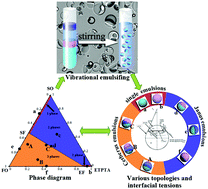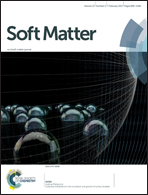Single, Janus, and Cerberus emulsions from the vibrational emulsification of oils with significant mutual solubility†
Abstract
Single, Janus, and Cerberus emulsions are prepared in one system consisting of three oils: silicone (SO), fluorocarbon (FO) and ethoxylated trimethylolpropane triacrylate (ETPTA) with mutual solubility. An aqueous solution of Pluronic F127, which is an poly(ethylene oxide)/poly(propylene oxide) co-polymer of average composition EO97PO68EO97, was employed as the continuous phase. The three-dimensional phase diagram of the oils was determined, and different oil compositions within the various regions of the phase diagram were emulsified by one-step vortex mixing with an F127 aqueous solution. The result showed single, Janus, and Cerberus emulsions within the different regions of the phase diagram; i.e. the emulsions reflected the equilibrium system. The topology of the Cerberus droplets is to an overwhelming extent linear-singlet and exclusively lobe order of EF/FO/SF. Since the results indicate a significant effect of the equilibrium interfacial tensions on the drop topology, thermodynamic calculations were made using the experimentally determined interfacial tensions. The results, as expected, show that the Cerberus emulsions are thermodynamically preferred over separate drops of the individual oils. In addition, the calculations demonstrate that the order of lobes within a drop is thermodynamically favored.



 Please wait while we load your content...
Please wait while we load your content...